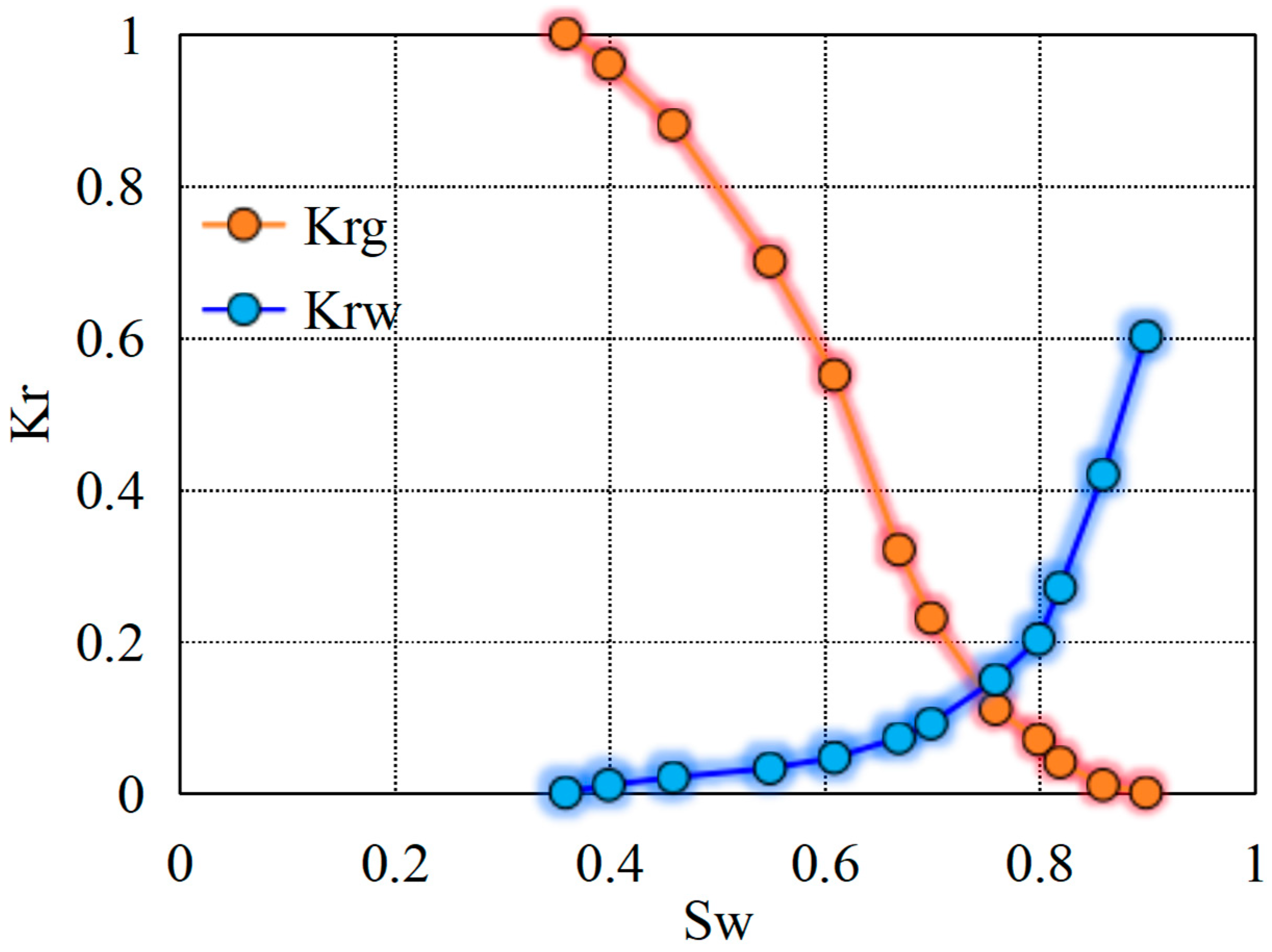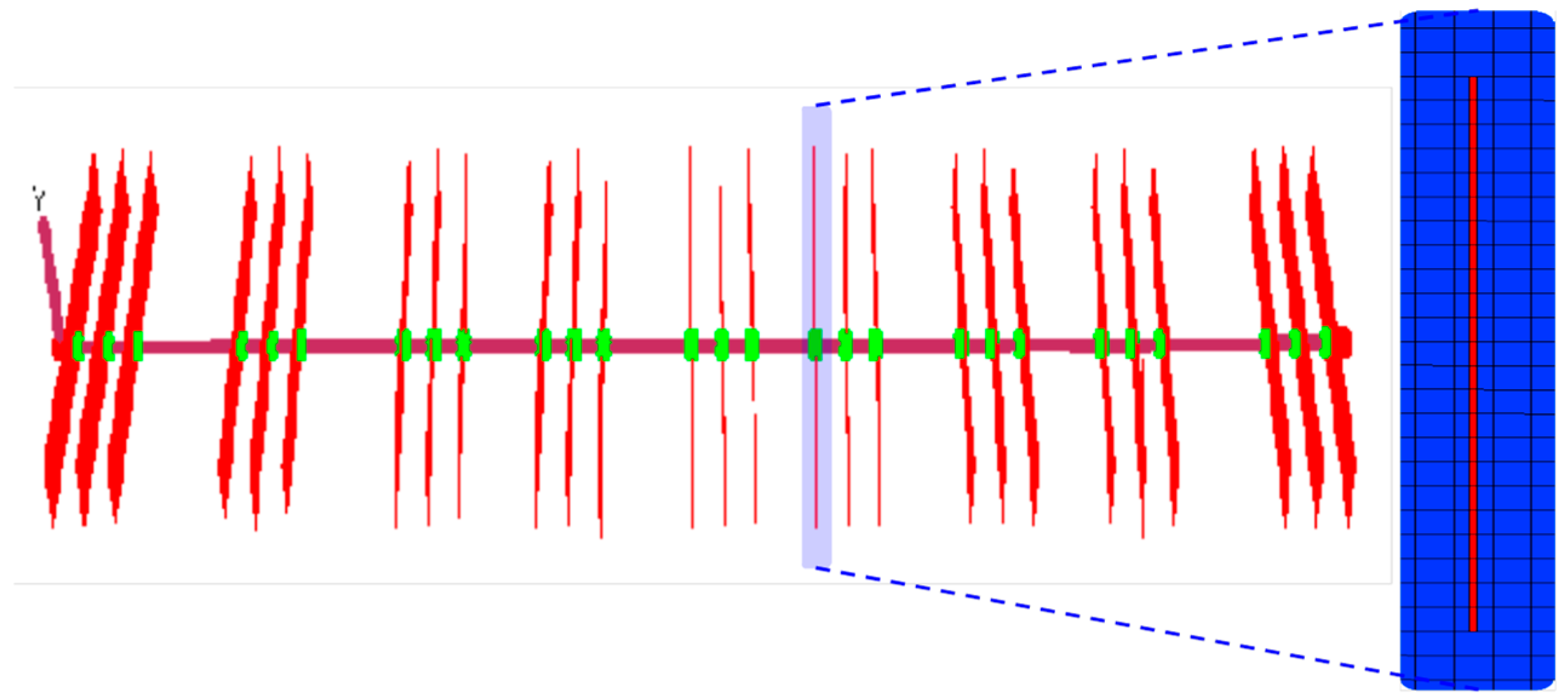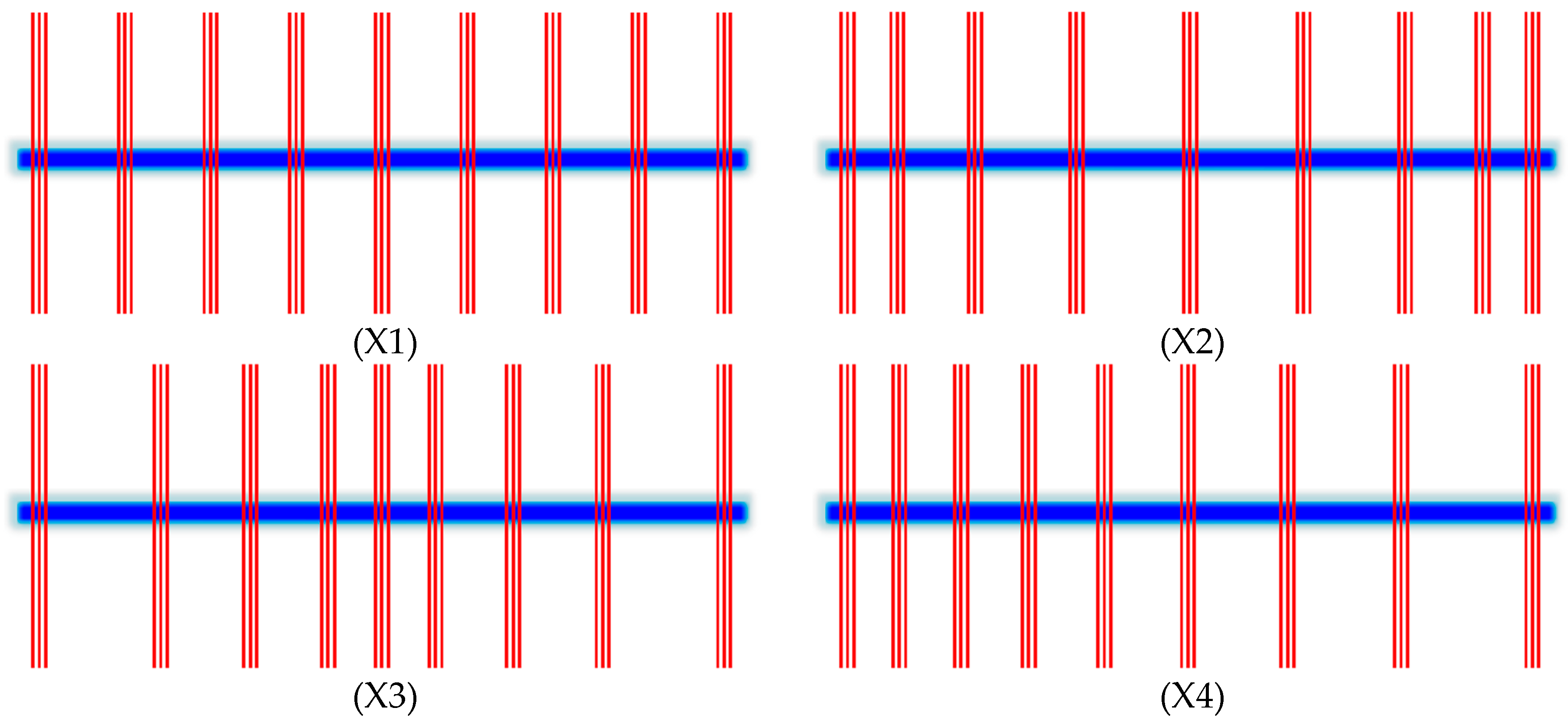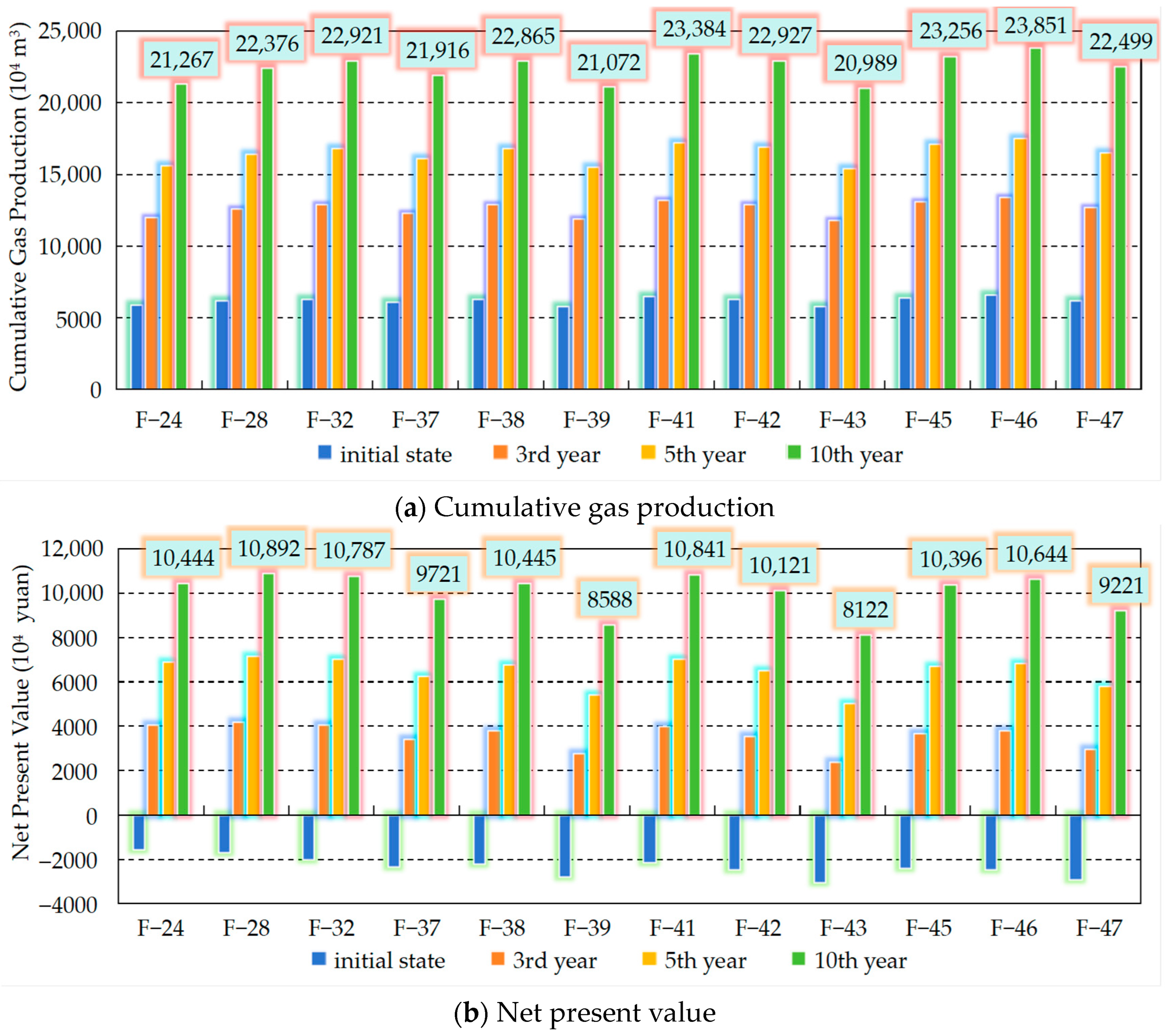Optimization of Fine-Fracture Distribution Patterns for Multi-Stage and Multi-Cluster Fractured Horizontal Wells in Tight Gas Reservoirs
Abstract
1. Introduction
2. Basic Model Establishment
2.1. Numerical Modeling and Grid Division
2.2. Formation and Fluid Properties Parameters
2.3. Treatment of Hydraulic Fractures
3. Simulation Scheme Design
3.1. Horizontal-Well Fracturing Parameters
3.2. Fine-Fracture Distribution Patterns
4. Reasonable Fracturing Design
4.1. Optimization Results Based on Deterministic Models
4.2. Exploration of Reasonable Fracture Distribution Patterns under Uncertainty Conditions
5. Conclusions
Author Contributions
Funding
Data Availability Statement
Acknowledgments
Conflicts of Interest
References
- Zhao, J.; Chen, X.; Li, Y.; Fu, B.; Xu, W. Numerical Simulation of Multi-stage Fracturing and Optimization of Perforation in a Horizontal Well. Pet. Explor. Dev. 2017, 44, 119–126. [Google Scholar] [CrossRef]
- Hou, B.; Chang, Z.; Wu, A.A.; Elsworth, D. Simulation of Competitive Propagation of Multi-fractures on Shale Oil Reservoir Multi-clustered Fracturing in Jimsar Sag. Acta Pet. Sin. 2022, 43, 75–90. [Google Scholar]
- Zhou, F.J.; Su, H.; Liang, X.Y.; Meng, L.F.; Yuan, L.S.; Li, X.H.; Liang, T.B. Integrated Hydraulic Fracturing Techniques to Enhance Oil Recovery from Tight Rocks. Pet. Explor. Dev. 2019, 46, 1007–1014. [Google Scholar] [CrossRef]
- Lu, Y.; Li, H.T.; Wang, J.C.; Liu, T.; Wu, K.L. Productivity Evaluation Model for Multi-cluster Fractured Wells Based on Volumetric Source Method. Energy Rep. 2022, 8, 8467–8479. [Google Scholar] [CrossRef]
- Zhang, H.; Bai, Y.H.; Fang, M.J.; Meng, F.K. Influencing Factors Analysis and Optimization of Hydraulic Fracturing in Multi-layered and Thin Tight Sandstone Gas Reservoir. Energies 2023, 16, 7797. [Google Scholar] [CrossRef]
- Parvizi, H.; Rezaei-Gomari, S.; Nabhani, F.; Turner, A.; Feng, W.C. Hydraulic Fracturing Performance in Tight Sandstone Gas Reservoirs with High Perm Streaks and Natural Fractures. In Proceedings of the EUROPEC 2015, Madrid, Spain, 1–4 June 2015; p. 174338. [Google Scholar] [CrossRef]
- Gao, Q.; Cheng, Y.; Yan, C. A 3D Numerical Model for Investigation of Hydraulic fracture Configuration in Multilayered Tight Sandstone Gas Reservoirs. J. Pet. Explor. Prod. Technol. 2018, 8, 1413–1424. [Google Scholar] [CrossRef]
- Ren, L.; Su, Y.L.; Wang, W.D.; Zhao, G.Y.; Yuan, B. Seepage Characteristics and Productivity Distribution of Segmented and Multi-cluster Fractured Horizontal Wells. J. Xi’an Shiyou Univ. Nat. Sci. Ed. 2013, 28, 55–59. [Google Scholar]
- Cheng, H.L.; Cheng, Z.Y.; Qin, Q.; Chen, H.; Wan, F.; Zhao, J.Y.; Li, J.P. Production Analysis of Multi-stage Fractured Horizontal Wells in Tight Oil Reservoirs. In Proceedings of the International Field Exploration and Development Conference 2023; Lin, J., Ed.; Springer Series in Geomechanics and Geoengineering; Springer: Singapore, 2024. [Google Scholar]
- Ren, L.; Su, Y.L.; Zhan, S.Y.; Meng, F.K. Progress of Research on Productivity Prediction Methods for Stimulated Reservoir Volume (SRV)-Fractured Horizontal Wells in Unconventional Hydrocarbon Reservoirs. Arab. J. Geosci. 2019, 12, 184. [Google Scholar] [CrossRef]
- Yong, R.; Zhou, F.J.; Li, M.H.; Song, Y.; Zhou, X.J.; Zhao, Z.H.; Li, B.; Qin, S.Y. Effects of Fracturing Parameters on Fracture Unevenness During Large-Stage Multi-cluster Fracturing in Horizontal Wells. Front. Energy Res. 2021, 9, 612486. [Google Scholar] [CrossRef]
- Ren, L.; Su, Y.L.; Lu, M.J.; Zhang, Y.H.; Cui, J. Optimization of Fracture Parameters of Segmented and Multi-cluster Fracturing Horizontal Wells in Unltra-low Permeability Reservoirs. J. Xi’an Shiyou Univ. Nat. Sci. Ed. 2015, 30, 49–52. [Google Scholar]
- Guo, T.K.; Wang, Y.P.; Chen, M.; Qu, Z.Q.; Tang, S.J.; Wen, D.W. Multi-stage and Multi-well Fracturing and Induced Stress Evaluation: An Experiment Study. Geoenergy Sci. Eng. 2023, 230, 212271. [Google Scholar] [CrossRef]
- Li, L.L.; Yao, J.; Li, Y.; Wu, M.L.; Zeng, Q.D.; Lu, R.R. Productivity Calculation and Distribution of Staged Multi-cluster Fractured Horizontal Wells. Pet. Explor. Dev. 2014, 41, 504–508. [Google Scholar] [CrossRef]
- Zeng, Q.D.; Tong, Y.; Yao, J. Production Distribution in Multi-cluster Fractured Horizontal Wells Accounting for Stress Interference. J. China Univ. Pet. (Ed. Nat. Sci.) 2019, 43, 99–107. [Google Scholar]
- Sarvaramini, E.; Miller, P.; Burnham, J.; Kivari, A. Quantifying Hydraulic Fracture Geometry and Morphology in a Multi-cluster, Multi-stage, Hydraulically Fractured Well Using Volume-to-First-Response Analysis. In Proceedings of the SPE Hydraulic Fracturing Technology Conference and Exhibition, Woodlands, TX, USA, 6–8 February 2024; p. 217832. [Google Scholar] [CrossRef]
- Wang, B.; Fang, Y.; Li, L.Z.; Liu, Z. Automatic Optimization of Multi-well Multi-stage Fracturing Treatments Combining Geomechanical Simulation, Reservoir Simulation and Intelligent Algorithm. Processes 2023, 11, 1759. [Google Scholar] [CrossRef]
- Yang, H.H.; Liu, X.Y.; Chu, X.S.; Xie, B.H.; Zhu, G.; Li, H.C.; Yang, J. Optimization of Tight Gas Reservoir Fracturing Parameters via Gradient Boosting Regression Modeling. Heliyon 2024, 10, e27015. [Google Scholar] [CrossRef] [PubMed]
- Ye, F.; Li, X.; Zhang, N.; Xu, F. Prediction of Single-Well Production Rate after Hydraulic Fracturing in Unconventional Gas Reservoirs Based on Ensemble Learning Model. Processes 2024, 12, 1194. [Google Scholar] [CrossRef]
- Khormali, A.; Ahmadi, S. Experimental and modeling analysis on the performance of 2-mercaptobenzimidazole corrosion inhibitor in hydrochloric acid solution during acidizing in the petroleum industry. J. Pet. Explor. Prod. Technol. 2023, 13, 2217–2235. [Google Scholar] [CrossRef]
- Kahhal, P.; Ghasemi, M.; Kashfi, M.; Ghorbani-Menghari, H.; Kim, J.H. A multi-objective optimization using response surface model coupled with particle swarm algorithm on FSW process parameters. Sci. Rep. 2022, 12, 2837. [Google Scholar] [CrossRef] [PubMed]
- Zhai, M.Y.; Wang, D.Y.; Zhang, Z.L.; Zhang, L.Y.; Yang, F.; Huang, B.; Zhong, A.H.; Li, L.C. Numerical simulation and multi-factor optimization of hydraulic fracturing in deep naturally fractured sandstones based on response surface method. Eng. Fract. Mech. 2022, 259, 108110. [Google Scholar] [CrossRef]
- Khormali, A.; Ahmadi, S. Prediction of barium sulfate precipitation in dynamic tube blocking tests and its inhibition for waterflooding application using response surface methodology. J. Pet. Explor. Prod. Technol. 2023, 13, 2267–2281. [Google Scholar] [CrossRef]







| Parameters (Unit) | Data |
|---|---|
| Formation water density, g/cm3 | 1.008 |
| Formation water volume factor | 1.03 |
| Rock compression coefficient, 10−5/bar | 4.3974 |
| Reservoir temperature, °C | 95 |
| Formation water viscosity, mPa·s | 0.5 |
| Formation water compression coefficient, 10−5/bar | 4.56 |
| Relative density of natural gas | 0.616 |
| Original formation pressure, bar | 276 |
| Pressure (bar) | Compression Factor (Zg) | Viscosity (mPa·s) |
|---|---|---|
| 10 | 1.0045 | 0.0134 |
| 20 | 0.9968 | 0.0137 |
| 40 | 0.9832 | 0.0143 |
| 100 | 0.9568 | 0.0161 |
| 120 | 0.9528 | 0.0167 |
| 160 | 0.952 | 0.0179 |
| 180 | 0.9552 | 0.0185 |
| 200 | 0.9608 | 0.0191 |
| 240 | 0.9792 | 0.0203 |
| 260 | 0.992 | 0.0209 |
| 280 | 1.0072 | 0.0215 |
| 300 | 1.0248 | 0.0221 |
| 320 | 1.0448 | 0.0227 |
| Factors / Levels | F1 | F2 | F3 | F4 | F5 |
|---|---|---|---|---|---|
| Horizontal-Well Length (m) | Number of Fracturing Stages | Half-Length of Fracture (m) | Fracture Conductivity (μm2·cm) | Stage Spacing (Different Design) | |
| L1 | 600 | 3~10 | 50 | 10 | X1 |
| L2 | 1000 | 3~12 | 100 | 15 | X2 |
| L3 | 1400 | 3~16 | 150 | 20 | X3 |
| L4 | 1800 | 3~18 | 200 | 30 | X4 |
| Factors / Levels | F5 | F6 | F7 |
|---|---|---|---|
| Fracture Distribution Pattern (Differences in Position) | Fracture Distribution Pattern (Differences in Length) | Cluster Number (per Stage) | |
| L1 | X1 | Y1 | 2 |
| L2 | X2 | Y2 | 3 |
| L3 | X3 | Y3 | 4 |
| L4 | X4 | Y4 | 5 |
Disclaimer/Publisher’s Note: The statements, opinions and data contained in all publications are solely those of the individual author(s) and contributor(s) and not of MDPI and/or the editor(s). MDPI and/or the editor(s) disclaim responsibility for any injury to people or property resulting from any ideas, methods, instructions or products referred to in the content. |
© 2024 by the authors. Licensee MDPI, Basel, Switzerland. This article is an open access article distributed under the terms and conditions of the Creative Commons Attribution (CC BY) license (https://creativecommons.org/licenses/by/4.0/).
Share and Cite
Ren, L.; Wang, J.; Zhao, C.; Jing, C.; Sun, J.; Zhou, D.; Xiang, F.; Gong, D.; Li, H. Optimization of Fine-Fracture Distribution Patterns for Multi-Stage and Multi-Cluster Fractured Horizontal Wells in Tight Gas Reservoirs. Processes 2024, 12, 1392. https://doi.org/10.3390/pr12071392
Ren L, Wang J, Zhao C, Jing C, Sun J, Zhou D, Xiang F, Gong D, Li H. Optimization of Fine-Fracture Distribution Patterns for Multi-Stage and Multi-Cluster Fractured Horizontal Wells in Tight Gas Reservoirs. Processes. 2024; 12(7):1392. https://doi.org/10.3390/pr12071392
Chicago/Turabian StyleRen, Long, Junzhang Wang, Cong Zhao, Cheng Jing, Jian Sun, Desheng Zhou, Fuguo Xiang, Diguang Gong, and Haiyan Li. 2024. "Optimization of Fine-Fracture Distribution Patterns for Multi-Stage and Multi-Cluster Fractured Horizontal Wells in Tight Gas Reservoirs" Processes 12, no. 7: 1392. https://doi.org/10.3390/pr12071392
APA StyleRen, L., Wang, J., Zhao, C., Jing, C., Sun, J., Zhou, D., Xiang, F., Gong, D., & Li, H. (2024). Optimization of Fine-Fracture Distribution Patterns for Multi-Stage and Multi-Cluster Fractured Horizontal Wells in Tight Gas Reservoirs. Processes, 12(7), 1392. https://doi.org/10.3390/pr12071392






